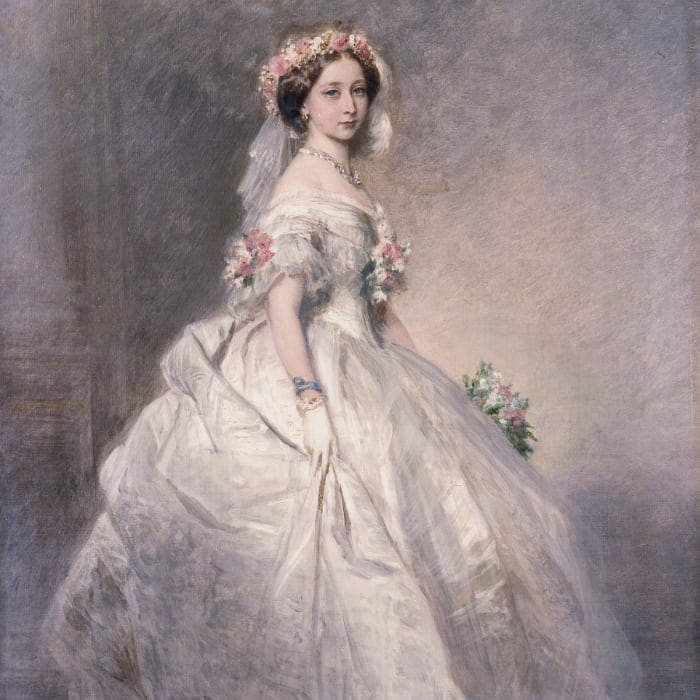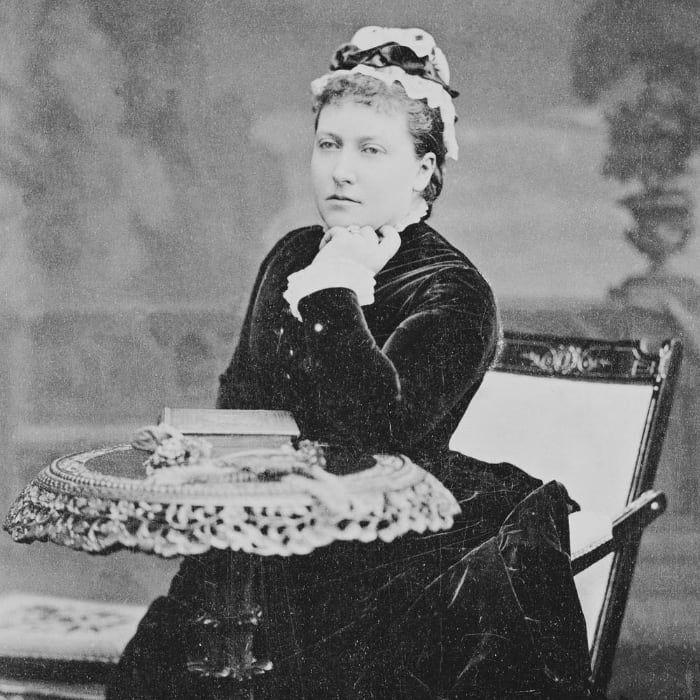VICTORIA, QUEEN OF THE UNITED KINGDOM
Young Victoria
Alexandrina Victoria was born on 24 May 1819 at Kensington Palace in London and was the only child of Edward, Duke of Kent, and Victoria of Saxe-Coburg-Saalfeld. Victoria was fifth in the line of succession after the four eldest sons of King George III: George, the Prince Regent; Frederick, Duke of York; William, Duke of Clarence; and her father, Edward, Duke of Kent.
Victoria was christened by the Archbishop of Canterbury, Charles Manners-Sutton, on 24 June 1819 in the Cupola Room at Kensington Palace. She was baptised Alexandrina after her godfather, Tsar Alexander I of Russia, and Victoria, after her mother.
Since the Duke of Kent was one of fifteen children, there was no reason to expect a crisis in the line of succession would develop within one generation but that is exactly what happened. Despite their strict upbringing, the seven surviving sons of George III were more inclined to taking mistresses than making suitable marriages and had produced a large number of illegitimate children who could not inherit. The Prince Regent had contracted an illegal marriage with his mistress, Maria Fitzherbert, while his brother, Frederick, who was next in line, had entered into a loveless marriage with his cousin, Frederica Charlotte of Prussia, and was unlikely to produce children.
Realising the need for an heir, the Prince Regent was practically blackmailed into making a dynastic marriage with Caroline of Brunswick but the couple put aside their mutual dislike long enough to produce a daughter, Charlotte. As the only legitimate grandchild of George III, much expectation was placed on the young girl’s shoulders, however her tragic death in childbirth in 1817 was a harsh blow. Since it was unlikely George and Caroline would produce further children, there was a frantic search for brides for the King’s unmarried sons who weren’t exactly in the first flush of youth.
The third son, William, Duke of Clarence, married Adelaide of Saxe-Meiningen, while the fourth son, Edward, Duke of Kent, married Victoria of Saxe-Coburg-Saalfeld. The seventh son, Adolphus, Duke of Cambridge, married Augusta of Hesse-Kassel, while the fifth son, Ernest Augustus, Duke of Cumberland, already married to his first cousin, Frederica of Mecklenburg-Strelitz, renewed his efforts to produce an heir before his brothers.
The brothers achieved their goal but with mixed results: Augusta of Cambridge, gave birth to a son, George, on 26 March 1819, while Adelaide of Clarence had a premature daughter, Charlotte, the following day. The Duchess of Kent gave birth to a girl on 24 May 1819, and three days later, Frederica of Cumberland had a boy, another George. Sadly, Adelaide’s daughter died a few hours after her birth, leaving Alexandrina Victoria of Kent fifth in line to the throne after her father and his three elder brothers. The only way Victoria could be displaced now would be if her parents produced a son or if Adelaide had more children. Adelaide would fall pregnant on three more occasions, however none of the infants survived.
Victoria was only a few months old when her father died on 23 January 1820 and he was followed a few days later by her grandfather, George III, who died on 29 January. The Prince Regent succeeded as George IV but his reign only lasted seven years and he was succeeded by his eldest surviving brother, William, as Frederick, Duke of York, had already died on 5 January 1827. As the highest ranked surviving grandchild of George III, Victoria became heir presumptive while her mother would act as regent should Victoria succeed as a minor. William had no love for the Duchess of Kent though, and he informed her at a dinner that he had every intention of staying alive until Victoria reached eighteen.
Victoria’s childhood was a lonely affair as she was kept in isolation from the rest of the family by her protective mother who believed the court was an immoral place. Victoria spent her days studying with her tutors and playing with her large doll collection until she retired to the bedroom she shared with her mother. The Duchess of Kent also organised a series of trips around England and Wales, much to William’s annoyance, and Victoria’s dislike.
A Love Match
In 1836, the Duchess of Kent’s youngest brother, Leopold I of Belgium, began to promote a match between Victoria and Prince Albert of Saxe-Coburg and Gotha, the son of the Duchess of Kent’s older brother, Ernst. William disapproved of the match, favouring Alexander of the Netherlands, however Victoria preferred Albert who she found handsome and charming. Since Victoria was only seventeen, no formal announcement of the engagement was made but it was a foregone conclusion.
True to his word, William IV died on 20 June 1837, a month after Victoria’s eighteenth birthday, and she was crowned on 28 June 1838 at Westminster Abbey. Since Hanover operated under Salic Law, which excluded females from the throne, the Hanoverian title passed to Ernest, Duke of Cumberland, who would also be Victoria’s heir until she had a child.
Much to Victoria’s chagrin, she was still required to live with her mother as she was unmarried so Victoria banished her to apartments in Buckingham Palace as far from her own as possible. The presence of her mother continued to plague Victoria and she was urged to marry to resolve the situation, however she refused to be hurried. When Prince Albert visited her in October 1839, none of their previous affection had diminished, so Victoria proposed to him five days later.
Albert and Victoria were married on 10 February 1840 in the Chapel Royal of St. James’s Palace and it was obvious the couple were besotted with each other. Victoria’s hopes of delaying motherhood were thwarted when she discovered she was pregnant with her first child not long after their marriage. Victoria disliked being pregnant and found newborns ugly creatures, however she rather enjoyed the process of begetting them and went on to have nine children over a seventeen year period. Victoria’s children thrived and married into the royal houses of Europe, earning Victoria the nickname, Grandmother of Europe. However, her legacy also had a dark side as her children were carriers of haemophilia and porphyria, medical conditions which would plague her descendants.
Widow of Windsor
Victoria’s mother died in March 1861 and despite their difficult relationship, Victoria mourned her loss greatly, however worse was to come when her beloved Albert died in December that same year, plunging Victoria into a deep depression from which she never recovered. Drowning in her grief, Victoria withdrew from the public, isolating herself in Windsor where she had Albert’s clothes laid out for him every morning just as when he was still alive. At Balmoral, Victoria became increasingly reliant on her manservant, John Brown, which led to salacious rumours she was having a romantic liaison with him or had even married him in secret. Victoria’s children disapproved of their mother’s association with Brown and while there is no evidence to suggest they were intimate, Victoria mourned his death keenly in 1883.
Slowly, Victoria was coaxed back to her royal duties and she attended the State Opening of Parliament for the first time since Albert’s death in 1866. During Victoria’s self-imposed exile, republicanism had been growing in popularity, fuelled by the establishment of the Third French Republic, however Victoria’s return to London renewed interest in the monarchy. As the tenth anniversary of Albert’s death approached, Victoria’s eldest son, Albert Edward, became gravely ill and Victoria began to fear she would lose him. When the Prince of Wales pulled through, Victoria rejoiced with a public parade through London and a grand service of thanksgiving in St. Paul’s Cathedral.
As Victoria’s popularity increased once more, republican feelings began to dissipate but it seems grief was never far away as the Queen mourned the loss of her second daughter, Alice, who died from typhoid on the anniversary of her father’s death. The following year, Victoria marked the birth of her first great-grandchild, Feodora of Saxe-Meiningen, lamenting how quickly the years seemed to be passing.
Queen Victoria celebrated her Diamond Jubilee in 1896 and upon her death on 22 January 1901, she had reigned for 63 years, 7 months and 2 days, making her the longest reigning monarch in British history until she was surpassed by her great-great granddaughter, Elizabeth II, in 2015.










